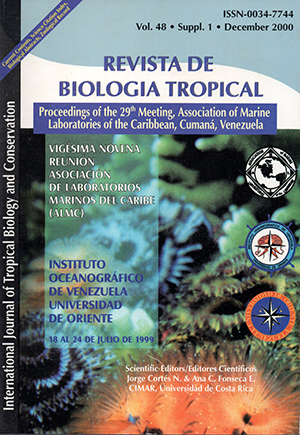Abstract
Organic extracts of the sponge Aplysina fistularis (Pallas 1766) were tested for antimicrobial activity against Gram positive bacteria (Staphylococcus aureus) and Gram negative bacteria (Escherichia coli, Klebsiel la pneumoniae and Pseudomonas aeruginosa). The minimal inhibitory concentration (MI C) and toxic activity of extract were determined. Susceptibility trials of organic fractions obtained by V LC: Hexane, EtOAc and CHCl, showed that EtOAc fraction has antibacterial activity against E. coli, while CHCl, fraction inhibited E. coli and S. aureus growth. The later refractioning of EtOAc fraction and the biodirected assays showed that fractions FI2 and F 13 of EtOAclHex and EtOAc F 14 were bioactive against Gram positive and Gram negative bacteria. Only EtOAc/MeOH Sf2 from subfractionig of EtOAc FI4 produced inhibition for E. coli and S. aureus. In Sf2 EtOAc/MeOH , MIC was moderate for S. aureus (MIC > 256 g/ml). F4 CHCI3IMeOH produced a high inhibition in S. aureus (MIC = 0.125 g/ml) and for E. coli (MIC > 16 g/ml). F10 CHCl3/MeOH showed a moderate activity against S. aureus(MIC > 128 g/ml) and low activity against E. coli (MIC = 512 g/ml). F10 CHCl3/MeOH did no present toxic activity against Artemia salina. The fractious F4 CHCl3/MeOH and Sf2 EtOAc/MeOH were toxic for this organism when the concentration was higher than 100 μglml. LC50 in both cases was 548.4 and 243.4 μg/ml respectively. Secondary metabolites of medium polarity obtained from A.fistularis have a wide spectrum of anti bacterial activity. Toxicity analysis suggests that only F10 CHCl3/MeOH has potential as an antimicrobial agent for clinical use.##plugins.facebook.comentarios##

This work is licensed under a Creative Commons Attribution 4.0 International License.
Copyright (c) 2000 Revista de Biología Tropical
Downloads
Download data is not yet available.


